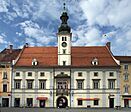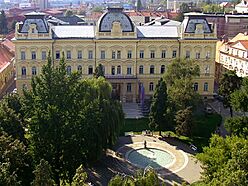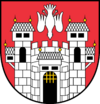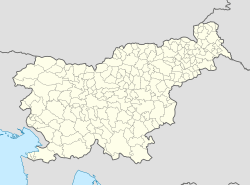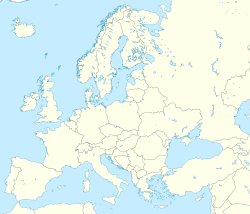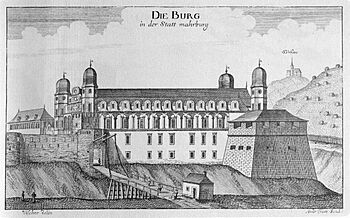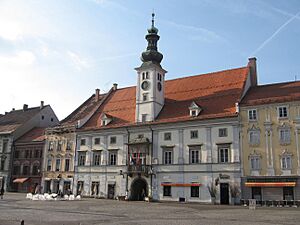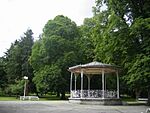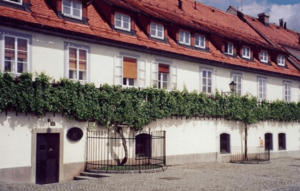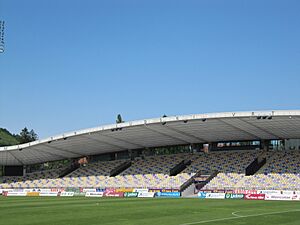Maribor facts for kids
Quick facts for kids
Maribor
|
|||
|---|---|---|---|
|
The Drava River with Lent in the background
Maribor Town Hall
Basilica of Our Mother of Mercy
Maribor Cathedral
Maribor Castle
University of Maribor
|
|||
|
|||
| Country | |||
| Traditional region | Styria | ||
| Statistical region | Drava | ||
| Municipality | Maribor | ||
| First mention | 1164 | ||
| Town privileges | 1254 | ||
| Area | |||
| • City | 40.98 km2 (15.82 sq mi) | ||
| Elevation | 274.7 m (901.2 ft) | ||
| Population
(2023)
|
|||
| • Urban | 96,209 | ||
| • Metro | 329,014 | ||
| • City Municipality | 113,000 | ||
| Demonym(s) | Mariborčan (male), Mariborčanka (female) | ||
| Time zone | UTC+01 (CET) | ||
| • Summer (DST) | UTC+02 (CEST) | ||
| Postal code |
2000
|
||
| Area code(s) | 02 (+386 2 if calling from abroad) | ||
| Climate | Cfb | ||
| Licence plate | MB | ||
Maribor (UK: /ˈmærɪbɔːr/ marr-IB-or, US: /ˈmɑːr-/ MAR--, Slovene: [ˈmáːɾibɔɾ]) is the second-largest city in Slovenia. It is the biggest city in the traditional region of Lower Styria. Maribor is an important center for business, government, education, and culture in eastern Slovenia.
The city was first mentioned as a castle in 1164. It became a settlement in 1209 and a full city in 1254. For a long time, Maribor was part of the Habsburg monarchy. In 1918, Rudolf Maister helped secure the city for the new State of Slovenes, Croats and Serbs. This state later joined with the Kingdom of Serbia to form the Kingdom of Yugoslavia. In 1991, Maribor became part of independent Slovenia.
In 2012, Maribor was chosen as a European Capital of Culture, sharing the title with the city of Guimarães in Portugal.
Contents
- City Name: How Maribor Got Its Name
- Maribor's History: From Ancient Times to Today
- Maribor's Geography and Climate
- Maribor's Architecture: Old Buildings and New Plans
- Parks and Green Spaces in Maribor
- Culture and Education in Maribor
- Sports in Maribor
- Transportation in Maribor
- Maribor's International Connections
- Images for kids
- See also
City Name: How Maribor Got Its Name
Maribor was first called Marpurch around 1145. Later, it was known as Marchburch or Marburc. This name comes from old German words meaning 'borderland' and 'fortress'. In modern times, its German name was Marburg an der Drau, which means 'Marburg on the Drava River'.
The Slovene name Maribor was created by Stanko Vraz in 1836. He made it up to sound like other place names, such as Brandenburg. Locally, people used to call it Marprk or Marprog. The name Maribor became popular among Slovenes in 1861. This happened when Lovro Toman published a song called Mar i bor, which means 'to care and to fight for'. The city is also known as Marburgum in Latin and Marburgo in Italian.
Maribor's History: From Ancient Times to Today
![]() Archbishop of Salzburg (1164–1555)
Archbishop of Salzburg (1164–1555)
![]() Habsburg Monarchy (1555–1804)
Habsburg Monarchy (1555–1804)
![]() Austrian Empire (1804–1867)
Austrian Empire (1804–1867)
![]() Austria-Hungary (1867–1918)
Austria-Hungary (1867–1918)
![]() State of Slovenes, Croats and Serbs (1918)
State of Slovenes, Croats and Serbs (1918)
![]() Kingdom of Yugoslavia (1918–1941)
Kingdom of Yugoslavia (1918–1941)
![]() Nazi Germany (1941–1945; annexed)
Nazi Germany (1941–1945; annexed)
![]() SFR Yugoslavia (1945–1991)
SFR Yugoslavia (1945–1991)
![]() Slovenia 1991–Present
Slovenia 1991–Present
Early Settlements: Prehistory and Roman Times
The oldest signs of people living in the Maribor area are from about 5,000 BC. This was during the Copper Age. Larger settlements from around 4400 to 4200 BC have been found. More settlements were discovered nearby, including one from the 4th millennium BC.
During the Bronze Age, around 3000 BC, more people settled in the Maribor area. In the 13th to 12th century BC, new settlements were found in Pekel. Around 1000 BC, new groups of settlers arrived. Old burial sites from this time have been found in areas like Mladinska ulica and Pobrežje.
In the Iron Age, people started building settlements on hills. One important hill town was Poštela in the Pohorje Mountains. It was used in the 2nd century BC.
During Roman times, the Maribor area was part of the Noricum province. It was on the border with Pannonia. Roman farms, called villae rusticae, were common here. An important trade route also passed through, connecting major Roman towns.
Medieval History: Castles, Trade, and Sieges
After the Roman Empire fell, Slavic people settled in the Maribor area. A Slavic cemetery from the 10th century AD was found in Radvanje. This area was part of different empires, including the Frankish Empire.
To protect against Hungarian raids, a castle was built on Pyramid Hill. This castle was first mentioned on October 20, 1164, as Castrum Marchburch. A town quickly grew around the castle. Maribor was first called a market town in 1204 and became a city in 1254.
The city grew fast after 1278. It built strong walls, and trade, winemaking, and crafts became very important. Maribor controlled trade in the region, especially wine. The first churches were built, and Jewish people also arrived, building their own neighborhood and the Maribor Synagogue.
In 1478, a second castle, now known as Maribor Castle, was built. In 1480 and 1481, King Matthias Corvinus tried to capture the city but failed. In 1496, all Jewish people were ordered to leave Maribor.
The Maribor Town Hall was built in 1515. In 1532, the Ottoman Empire attacked Maribor with a huge army led by Suleiman the Magnificent. The city was defended by its local soldiers and citizens. Maribor successfully defended itself, and a legend tells of a shoemaker who flooded the Ottoman army.
Modern Period: Growth and Changes
In the 17th century, many fires destroyed parts of Maribor, leading to rebuilding. The plague also caused many deaths in 1646, 1664, and 1680. After the plague ended, a plague column was built in 1681.
In 1846, the Southern Railway came through Maribor. This brought a lot of economic growth. In 1859, Bishop Anton Martin Slomšek moved his church headquarters to Maribor. He encouraged the use of the Slovene language. Maribor also got its first higher school.
The first daily Slovenian newspaper started in 1868. On April 4, 1883, the first electric light in Slovene areas was installed in Maribor. The famous electrical engineer Nikola Tesla lived in Maribor from 1878 to 1879. The Maribor National Hall was built in 1899, becoming a key place for Slovenes in Styria.
By 1900, most people in the city were Austrian German speakers. However, the areas around the city were mostly Slovene. In 1913, a new bridge, now called the Old Bridge, was opened over the Drava River. During World War I, tensions grew between Austrian Germans and Slovenes.
After the Austro-Hungarian Empire fell in 1918, both the new State of Slovenes, Croats and Serbs and German Austria claimed Maribor. Slovene Major Rudolf Maister took control of the city with his troops. He disarmed Austrian soldiers and secured Maribor for the Slovene state.
On January 27, 1919, an incident occurred where Slovenian troops fired on Austrian Germans gathered in the marketplace. Nine people died. This event is known as Marburg's Bloody Sunday. Maribor officially became part of the Kingdom of Serbs, Croats and Slovenes in 1919. Rudolf Maister is now considered a Slovenian national hero for his actions.
After 1918, many Austrian Germans left Maribor. The city became the fastest-developing city in Yugoslavia until World War II.
World War II and Recent History

In 1941, Nazi Germany took control of Lower Styria, including Maribor. Adolf Hitler visited Maribor on April 26, 1941. The Nazis began to remove Slovenes from the area. This led to resistance from Slovene partisans.
Maribor was an important industrial city with arms factories. Because of this, the Allies bombed the city many times during the war. About 47% of the city was destroyed, and many civilians died. By the end of the war, Maribor was one of the most damaged cities in Yugoslavia.
After World War II, Maribor became part of SFR Yugoslavia. The city was rebuilt and became a major industrial center. In 1991, Slovenia became independent. This caused economic challenges for Maribor, as it lost its market in Yugoslavia. Unemployment rose.
In 2012, Maribor was a European Capital of Culture. In 2013, it was the European Youth Capital.
Maribor's Geography and Climate
City Landscape and Hills
The Drava River flows through Maribor. On the river, there is Maribor Island (Mariborski otok), which has the city's oldest public bath.
Maribor has two main hills: Calvary Hill and Pyramid Hill. Both are surrounded by vineyards. Pyramid Hill has the ruins of the first Maribor castle and a chapel. It offers great views of the city and the countryside.
City Districts and Connections
Maribor is divided into 11 districts (Slovene: mestne četrti). The Drava River separates some districts in the north from others in the south. These districts are connected by four road bridges, a rail bridge, and a pedestrian bridge.
- Brezje–Dogoše–Zrkovci
- Center
- Ivan Cankar
- Koroška Vrata
- Magdalena
- Nova Vas
- Pobrežje
- Radvanje
- Studenci
- Tabor
- Tezno
Maribor's Climate: Warm Summers and Sunny Days
Maribor has a climate with warm summers and cold winters. Average temperatures are around zero degrees Celsius in winter. Summers are generally warm, with July temperatures often above 20 degrees Celsius. This warm weather is good for Maribor's wine tradition.
The city gets about 900 millimeters (35 inches) of rain each year. It is also one of the sunniest cities in Slovenia, with an average of 266 sunny days a year. The highest temperature ever recorded in August was 40.6 °C (105.1 °F) in 2013.
| Climate data for Maribor Edvard Rusjan Airport (1991–2020 normals, extremes 1950–2020) | |||||||||||||
|---|---|---|---|---|---|---|---|---|---|---|---|---|---|
| Month | Jan | Feb | Mar | Apr | May | Jun | Jul | Aug | Sep | Oct | Nov | Dec | Year |
| Record high °C (°F) | 17.8 (64.0) |
21.4 (70.5) |
25.5 (77.9) |
28.9 (84.0) |
32.1 (89.8) |
35.3 (95.5) |
37.7 (99.9) |
39.7 (103.5) |
32.7 (90.9) |
27.0 (80.6) |
25.7 (78.3) |
19.5 (67.1) |
39.7 (103.5) |
| Mean daily maximum °C (°F) | 4.2 (39.6) |
6.9 (44.4) |
11.8 (53.2) |
16.9 (62.4) |
21.4 (70.5) |
25.3 (77.5) |
27.1 (80.8) |
26.7 (80.1) |
21.4 (70.5) |
16.1 (61.0) |
9.9 (49.8) |
4.6 (40.3) |
16.0 (60.8) |
| Daily mean °C (°F) | 0.0 (32.0) |
1.7 (35.1) |
6.0 (42.8) |
11.0 (51.8) |
15.6 (60.1) |
19.5 (67.1) |
21.0 (69.8) |
20.4 (68.7) |
15.5 (59.9) |
10.7 (51.3) |
5.7 (42.3) |
0.8 (33.4) |
10.7 (51.3) |
| Mean daily minimum °C (°F) | −3.8 (25.2) |
−2.9 (26.8) |
0.7 (33.3) |
5.0 (41.0) |
9.6 (49.3) |
13.3 (55.9) |
14.7 (58.5) |
14.4 (57.9) |
10.4 (50.7) |
6.2 (43.2) |
2.1 (35.8) |
−2.8 (27.0) |
5.6 (42.1) |
| Record low °C (°F) | −26.3 (−15.3) |
−26.1 (−15.0) |
−23.9 (−11.0) |
−9.5 (14.9) |
−4.5 (23.9) |
0.5 (32.9) |
3.5 (38.3) |
4.5 (40.1) |
−1.7 (28.9) |
−6.6 (20.1) |
−17.4 (0.7) |
−24.1 (−11.4) |
−26.3 (−15.3) |
| Average precipitation mm (inches) | 33 (1.3) |
43 (1.7) |
49 (1.9) |
62 (2.4) |
97 (3.8) |
107 (4.2) |
103 (4.1) |
101 (4.0) |
113 (4.4) |
87 (3.4) |
82 (3.2) |
60 (2.4) |
939 (37.0) |
| Average extreme snow depth cm (inches) | 5 (2.0) |
6 (2.4) |
2 (0.8) |
0 (0) |
0 (0) |
0 (0) |
0 (0) |
0 (0) |
0 (0) |
0 (0) |
1 (0.4) |
3 (1.2) |
1.4 (0.6) |
| Average precipitation days (≥ 0.1 mm) | 8 | 8 | 9 | 12 | 14 | 13 | 12 | 11 | 11 | 11 | 12 | 10 | 131 |
| Mean monthly sunshine hours | 83.4 | 112.8 | 155.0 | 195.8 | 240.2 | 256.9 | 277.5 | 259.2 | 183.9 | 141.5 | 80.4 | 68.6 | 2,055.2 |
| Source 1: Slovenian Environment Agency (snow depth 1981–2010) | |||||||||||||
| Source 2: NOAA (sun 1991–2020) | |||||||||||||
| Climate data for Maribor (1991–2020 normals, extremes 1950–2020) | |||||||||||||
|---|---|---|---|---|---|---|---|---|---|---|---|---|---|
| Month | Jan | Feb | Mar | Apr | May | Jun | Jul | Aug | Sep | Oct | Nov | Dec | Year |
| Record high °C (°F) | 17.3 (63.1) |
23.0 (73.4) |
25.4 (77.7) |
28.7 (83.7) |
33.0 (91.4) |
35.6 (96.1) |
37.8 (100.0) |
39.8 (103.6) |
32.9 (91.2) |
27.3 (81.1) |
23.6 (74.5) |
20.1 (68.2) |
39.8 (103.6) |
| Mean daily maximum °C (°F) | 4.1 (39.4) |
6.9 (44.4) |
11.6 (52.9) |
16.6 (61.9) |
20.9 (69.6) |
24.7 (76.5) |
26.5 (79.7) |
26.1 (79.0) |
20.9 (69.6) |
15.8 (60.4) |
9.6 (49.3) |
4.4 (39.9) |
15.7 (60.3) |
| Daily mean °C (°F) | −0.1 (31.8) |
1.6 (34.9) |
5.7 (42.3) |
10.4 (50.7) |
14.8 (58.6) |
18.6 (65.5) |
20.3 (68.5) |
19.8 (67.6) |
14.9 (58.8) |
10.2 (50.4) |
5.4 (41.7) |
0.7 (33.3) |
10.2 (50.4) |
| Mean daily minimum °C (°F) | −3.8 (25.2) |
−2.9 (26.8) |
0.6 (33.1) |
4.9 (40.8) |
9.2 (48.6) |
13.1 (55.6) |
14.8 (58.6) |
14.6 (58.3) |
10.3 (50.5) |
5.9 (42.6) |
1.8 (35.2) |
−2.8 (27.0) |
5.5 (41.9) |
| Record low °C (°F) | −23.0 (−9.4) |
−22.6 (−8.7) |
−20.5 (−4.9) |
−6.6 (20.1) |
−5.5 (22.1) |
1.1 (34.0) |
4.1 (39.4) |
3.9 (39.0) |
−2.4 (27.7) |
−6.9 (19.6) |
−14.3 (6.3) |
−21.8 (−7.2) |
−23.0 (−9.4) |
| Average precipitation mm (inches) | 31 (1.2) |
42 (1.7) |
49 (1.9) |
63 (2.5) |
101 (4.0) |
104 (4.1) |
101 (4.0) |
111 (4.4) |
116 (4.6) |
89 (3.5) |
83 (3.3) |
59 (2.3) |
949 (37.4) |
| Average precipitation days (≥ 0.1 mm) | 9 | 8 | 10 | 12 | 15 | 14 | 14 | 12 | 12 | 11 | 12 | 11 | 140 |
| Source: Slovenian Environment Agency | |||||||||||||
Maribor's Architecture: Old Buildings and New Plans
Maribor has many old and important buildings. Parts of the old city walls still stand, like the Judgement Tower, the Water Tower, and the Jewish Tower. Maribor Cathedral was built in the Gothic style in the 13th century. The Maribor Synagogue was built in the 14th century and is one of Europe's oldest synagogues. Today, it is a cultural center.
Other famous medieval buildings include Maribor Castle, Betnava Castle, and the ruins of Upper Maribor Castle on Pyramid Hill. The Town Hall was built in the Renaissance style. The Plague Column is a beautiful example of Baroque style.
There were plans for a new modern area called the Drava Gate, also known as Maribor Manhattan. This project would include new apartments, offices, and a tall skyscraper. However, it has been put on hold due to money issues.
In 2008, the Studenci Footbridge was updated. Its design won an award. In 2010, Maribor held a competition for new designs for the Drava River banks, a new art gallery, and a new footbridge. The footbridge and riverbanks will be built soon. A new cultural center called MAKS is also being built.
A new Faculty of Medicine building was started in 2011 and finished in 2013. There are also plans to renovate the Maribor Public Library and Town Hall Square. The Maribor Island in the Drava River is also planned for renovation.
Parks and Green Spaces in Maribor
Maribor City Park is the main park in the city. It has a City Aquarium and Terrarium. A long path leads to the Three Ponds (Trije ribniki). The park has over 100 different types of trees.
Culture and Education in Maribor
Maribor is home to the University of Maribor, which was founded in 1975. There are also other higher education schools like Alma Mater Europaea. High schools include Maribor High School No. 1 and Maribor High School No. 2.
Every June, the two-week Lent Festival takes place. It is named after the Lent waterfront area. This festival has hundreds of music, theater, and other events. Performers from all over the world come to the festival.
Maribor is famous for its wine and delicious food. Some local dishes include mushroom soup with buckwheat, sausages with sauerkraut, and a special cheese cake called gibanica. The Vinag Wine Cellar is huge, covering 20,000 square meters (215,000 sq ft) and stretching for 2 kilometers (1.2 miles). It holds 5.5 million liters (1.4 million US gallons) of wine.
The Old Vine House (Hiša stare trte) at Lent has the world's oldest grapevine. This grapevine, called Žametovka, is over 400 years old. It was even listed in the Guinness World Records in 2004.
Maribor has several radio stations, including Radio City, Radio NET FM, and Radio Maribor. The Pekarna Cultural Centre is a place for alternative arts and culture. It is located in an old military bakery area.
Sports in Maribor
Team Sports: Football, Basketball, and More
Maribor is home to the football club NK Maribor. They play in the top Slovenian league, the Slovenian PrvaLiga. NK Maribor has won the national title a record 16 times. They have also played in the UEFA Champions League group stage three times. Their home stadium is Ljudski vrt.
| Club | Sport | League | Venue |
|---|---|---|---|
| NK Maribor | Football | Slovenian PrvaLiga | Ljudski vrt |
| ŽNK MB Tabor | Football | Slovenian Women's Football League | Tabor Sports Park |
| AKK Branik Maribor | Basketball | Slovenian Third Basketball League | Lukna Sports Hall |
| ŽKD Maribor | Basketball | Slovenian Women's Basketball League | Tabor Hall |
| RK Maribor Branik | Handball | Slovenian Second Handball League | Tabor Hall |
| OK Maribor | Volleyball | Slovenian Volleyball League | Tabor Hall |
| OK OTP Banka Branik | Volleyball | Slovenian Women's Volleyball League | Lukna Sports Hall |
| HDK Maribor | Ice hockey | Ö Eishockey Liga, Slovenian National Championship | Tabor Ice Hall |
Winter Sports: Skiing on Pohorje
The Maribor Pohorje Ski Resort is right outside the city on the Pohorje mountain. It has hosted women's slalom and giant slalom races for the Alpine Skiing World Cup. This competition is called the Golden Fox (Slovene: Zlata lisica). It first took place in 1964.
Hosting Major Sports Events
In November 2012, Maribor hosted the World Youth Chess Championship. The city's Ljudski vrt stadium was also a venue for the 2012 UEFA European Under-17 Championship and the 2021 UEFA European Under-21 Championship. In July 2023, Maribor hosted the 17th European Youth Olympic Festival.
Adventure Parks for Fun
Maribor has several sports parks for adventure. These include the Pohorje Adrenaline Park, the Pohorje Bike Park, and the Betnava Adventure Park. These parks offer activities like ropes courses and zip-lines.
Transportation in Maribor
- List of bridges in Maribor
- Maribor railway station
- Tauern Railway
- Maribor Edvard Rusjan Airport
Maribor's International Connections
Twin Towns and Sister Cities
Maribor is connected with many cities around the world as twin towns or sister cities:
 Royal Borough of Greenwich, London, United Kingdom, since 1967
Royal Borough of Greenwich, London, United Kingdom, since 1967 Kraljevo, Serbia, since 1970
Kraljevo, Serbia, since 1970 Marburg, Germany, since 1979
Marburg, Germany, since 1979 Udine, Italy, since 1985
Udine, Italy, since 1985 Szombathely, Hungary, since 1985
Szombathely, Hungary, since 1985 Graz, Austria, since 1987
Graz, Austria, since 1987 Pétange, Luxembourg, since 1992
Pétange, Luxembourg, since 1992 Osijek, Croatia, since 1995
Osijek, Croatia, since 1995 Tours, France, since 1997
Tours, France, since 1997 Saint Petersburg, Russia, since 2001
Saint Petersburg, Russia, since 2001 Pueblo, Colorado, United States, since 2006
Pueblo, Colorado, United States, since 2006 Kharkiv, Ukraine, since 2012
Kharkiv, Ukraine, since 2012 Hangzhou, China, since 2017
Hangzhou, China, since 2017 Chongqing, China, since 2017
Chongqing, China, since 2017
Partner Cities
Maribor also has partnerships with these cities:
 Kumanovo, North Macedonia, since 2014
Kumanovo, North Macedonia, since 2014 Ningbo, China, since 2014
Ningbo, China, since 2014 Nanjing, China, since 2015
Nanjing, China, since 2015 Nanchang, China, since 2015
Nanchang, China, since 2015 Novi Sad, Serbia, since 2015
Novi Sad, Serbia, since 2015 Huai'an, China, since 2015
Huai'an, China, since 2015 Makarska, Croatia, since 2015
Makarska, Croatia, since 2015 Yancheng, China, since 2015
Yancheng, China, since 2015 Wuxi, China, since 2015
Wuxi, China, since 2015 Vologda, Vologda Oblast, Russia, since 2016
Vologda, Vologda Oblast, Russia, since 2016 Bar, Montenegro, since 2016
Bar, Montenegro, since 2016 Kutaisi, Georgia, since 2016
Kutaisi, Georgia, since 2016 Maladzyechna, Belarus, since 2016
Maladzyechna, Belarus, since 2016 Wuhan, China, since 2016
Wuhan, China, since 2016 Mahallat, Iran, since 2016
Mahallat, Iran, since 2016 Sari, Iran, since 2016
Sari, Iran, since 2016 Veliko Tarnovo, Bulgaria, since 2016
Veliko Tarnovo, Bulgaria, since 2016 Smederevo, Serbia, since 2017
Smederevo, Serbia, since 2017 Oryol, Oryol Oblast, Russia, since 2017
Oryol, Oryol Oblast, Russia, since 2017 Xi'an, China, since 2017
Xi'an, China, since 2017 Jinan, China, since 2018
Jinan, China, since 2018
Images for kids
See also
 In Spanish: Maribor para niños
In Spanish: Maribor para niños



